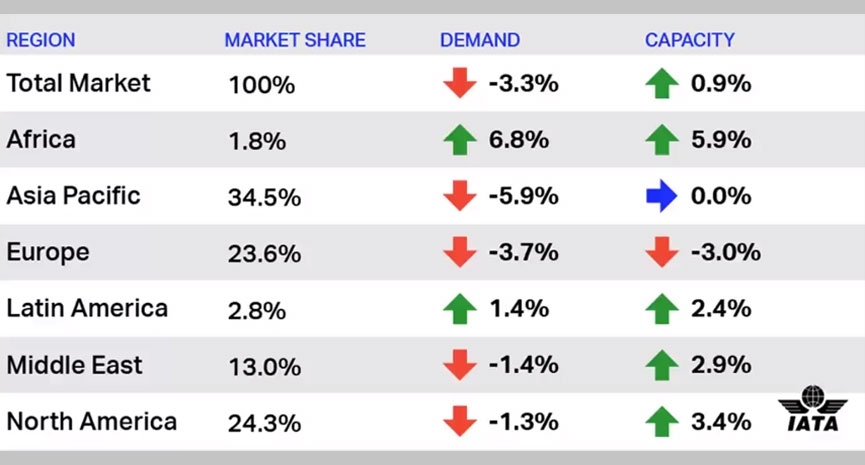Africa records 6.8% increase in freight demand in January: IATA
International Air Transport Association (IATA) released data for global air freight markets showing that demand, measured in cargo tonne kilometres (CTKs), decreased by 3.3 percent in January 2020, compared to the same period in 2019.

March 04, 2020: The International Air Transport Association (IATA) released data for global air freight markets showing that demand, measured in cargo tonne kilometres (CTKs), decreased by 3.3 percent in January 2020, compared to the same period in 2019.
African carriers posted the fastest growth of any region for the 11th consecutive month in January 2020, with an increase in demand of 6.8 percent compared to the same period a year earlier. Growth on the smaller Africa-Asia trade lanes (up 12.4 percent in 2019) contributed to the positive performance. Capacity grew 5.9 percent year-on-year.
”January marked the tenth consecutive month of year-on-year declines in cargo volumes. The air cargo industry started the year on a weak footing. There was optimism that an easing of US-China trade tensions would give the sector a boost in 2020. But that has been overtaken by the COVID-19 outbreak, which has severely disrupted global supply chains, although it did not have a major impact on January’s cargo performance. Tough times are ahead. The course of future events is unclear, but this is a sector that has proven its resilience time and again,” said Alexandre de Juniac, IATA’s director general and CEO.
Cargo capacity, measured in available cargo tonne kilometers (ACTKs), rose by 0.9 percent year-on-year in January 2020. Capacity growth has now outstripped demand growth for 21 consecutive months.
It is unlikely that the COVID-19 outbreak had very much to do with January’s weak performance. Lunar New Year in 2020 was earlier than in 2019. This skewed 2020 numbers towards weakness as many Chinese manufacturers would be closed for the holiday period. February performance will give a better picture of how COVID-19 is impacting global air cargo.
Airlines in Latin America and Africa were the only regions to record growth in air freight demand compared to January 2019. Meanwhile, Asia-Pacific and Europe suffered sharp declines in year-on-year growth in total air cargo volumes in January 2020, and North American and Middle East carriers experienced a more moderate decline.
Asia-Pacific airlines saw demand for air cargo contract by 5.9 percent in January 2020, compared to the year-earlier period. This was the sharpest drop in freight demand of any region for the month. Capacity growth was flat. Seasonally-adjusted cargo demand rose slightly however, following the thawing of US-China trade relations. The impact of COVID-19 is expected to affect February’s performance.
North American airlines saw demand decrease by 1.3 percent in January 2020, compared to the same period a year earlier. Capacity increased by 3.4 percent. Seasonally-adjusted cargo demand rose slightly, however, amid a more supportive operating environment and following the thawing of US-China trade relations.
European airlines posted a 3.7 percent decrease in cargo demand in January 2020 compared to the same period a year earlier – more than double the 1.3 percent drop in year-on-year demand in December. Seasonally-adjusted demand also dropped sharply, disrupting the positive trend that started mid-2019. Capacity decreased by 3.0 percent year-on-year.
Middle Eastern airlines’ cargo volumes decreased 1.4 percent in January 2020 compared to the year-ago period. Capacity increased by 2.9 percent. Against a backdrop of operational and geopolitical challenges facing some of the region’s key airlines, seasonally-adjusted freight volumes ticked down in January, but a modest upwards trend has been sustained. However, given the Middle East’s position connecting trade between China and the rest of the world, the region’s carriers have significant exposure to the impact of COVID-19 in the period ahead.
Latin American airlines experienced an increase in freight demand in January 2020 of 1.4 percent compared to January 2019 – reversing the 2.5 percent decrease in December. Seasonally-adjusted freight volumes in the region also ticked upwards, underpinned by new route connections, which is a positive development for the region’s carriers. Capacity increased by 2.4 percent year-on-year.


